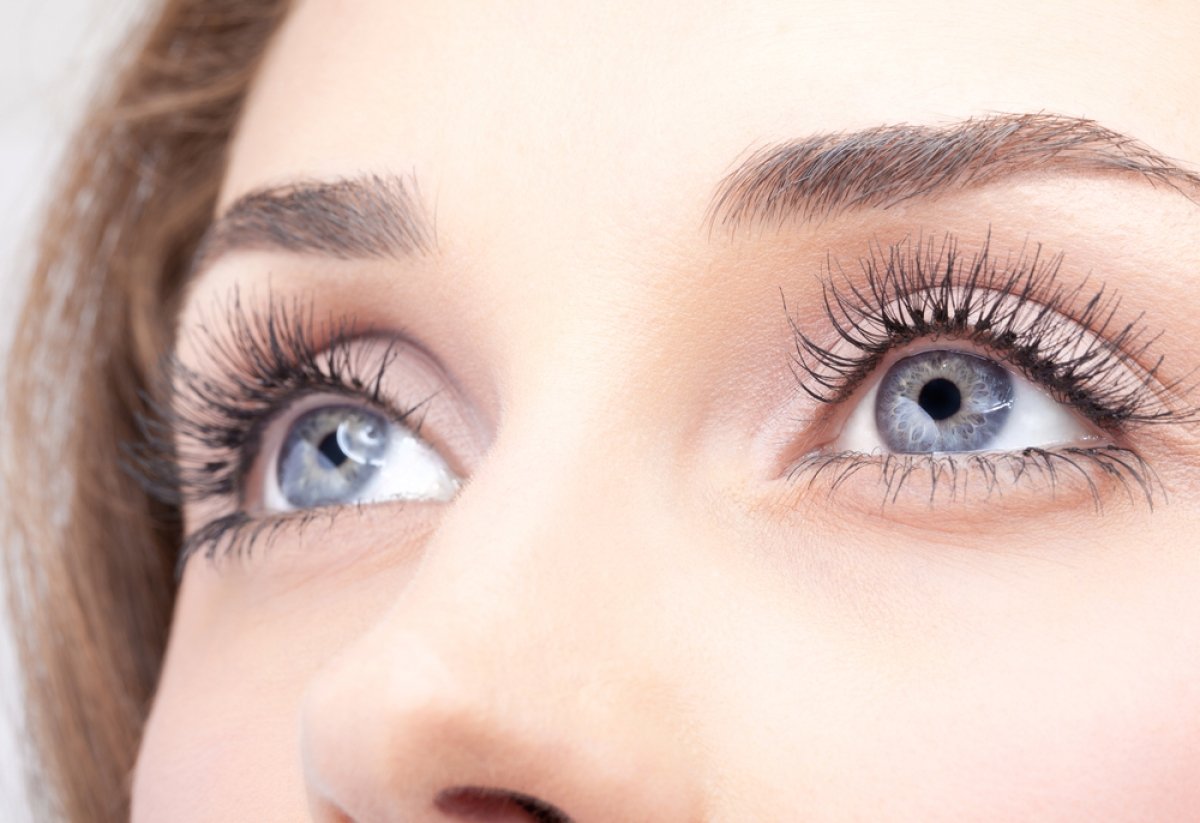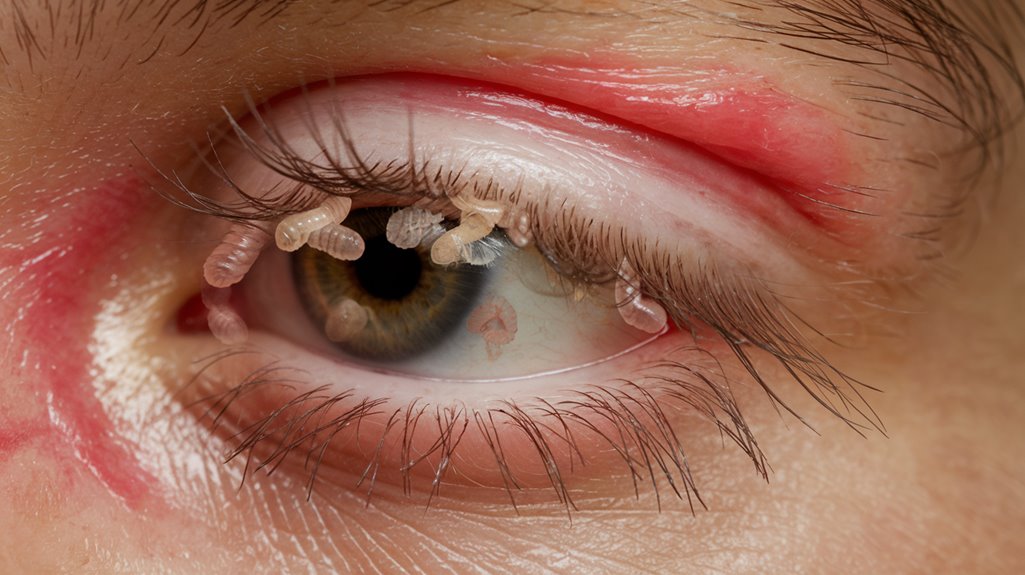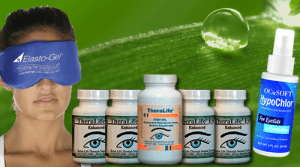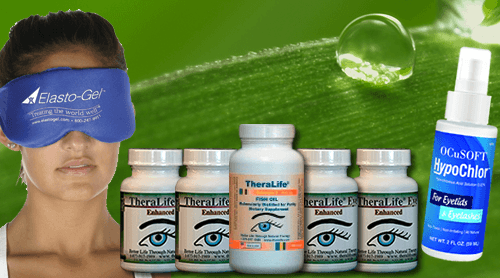Theralife.com offers a comprehensive solution for managing Demodex blepharitis, a hidden cause of eyelid inflammation. Their products focus on natural treatments that enhance eye health and improve symptoms like itchiness, crusty lashes, and burning sensations. By emphasizing eyelid hygiene and utilizing natural ingredients, Theralife.com provides effective relief and helps prevent symptom progression. For those dealing with persistent issues, their products, combined with recommended lifestyle changes, can significantly improve eye health and comfort, ensuring a proactive approach to managing Demodex blepharitis.
Best Demodex Blepharitis Treatment From TheraLife
Key Takeaways
- Demodex blepharitis is caused by an overpopulation of Demodex mites in eyelash follicles and sebaceous glands.
- Symptoms include itchy eyelids, crusty lashes, redness, and a burning sensation, especially worsening in the morning.
- Diagnosis involves slit-lamp microscopy to detect cylindrical dandruff on eyelashes, indicative of mite infestation.
- Treatment includes regular eyelid hygiene, tea tree oil products, and medications like ivermectin to reduce mite populations.
- Persistent symptoms despite self-care require professional evaluation to prevent complications and manage inflammation effectively.
Understanding Demodex Mites
While often overlooked, Demodex mites play a significant role in ocular surface health. These microscopic arachnids, mainly found on human skin, primarily inhabit the eyelash follicles and sebaceous glands.
Mite behavior includes feeding on sebum and cellular debris, which can influence your eyelid’s microenvironment. This activity is generally harmless, but when mite populations proliferate, they may disrupt normal eyelid function. For individuals suffering from blepharitis, utilizing products like the TheraLife® Dry Eye One Month Starter Kit can provide comprehensive treatment and rapid symptom relief.
Maintaining proper eyelid hygiene is essential to managing Demodex populations. Regular cleaning with lid scrubs or tea tree oil-based products helps reduce excess mites, thereby preserving ocular health.
Evidence suggests that diligent eyelid hygiene can prevent potential complications. By understanding the behavior of Demodex mites, you can take proactive steps to support your eye health and comfort.
How Demodex Mites Contribute to Blepharitis
You mightn’t realize it, but Demodex mites can play a significant role in the development of blepharitis by causing inflammation. These microscopic mites infest your eyelash follicles, leading to irritation and discomfort. Studies show that their presence can trigger an immune response, exacerbating symptoms and making effective management vital. Diagnosis typically involves examination for cylindrical dandruff on eyelashes, with ophthalmologists using magnification and fluorescence dyes for detection.
Mites’ Role in Inflammation
Demodex mites, microscopic organisms residing naturally on human skin, play a significant role in the inflammatory processes associated with blepharitis. These mites are primarily found in hair follicles and sebaceous glands, where their behavior can trigger an immune response in susceptible individuals. When mites overpopulate, they can cause irritation and inflammation. The body’s immune system identifies the mites and their waste products as foreign invaders, initiating an inflammatory response. This response can lead to symptoms such as redness, itching, and swelling of the eyelids. It’s important to recognize that while Demodex mites are a normal part of the skin’s ecosystem, their excessive presence can disrupt ocular surface health, necessitating targeted treatment to alleviate inflammation and restore comfort. For those suffering from blepharitis, maintaining proper eyelid hygiene is crucial to managing symptoms and preventing bacterial growth.
Eyelash Follicle Infestation
When these microscopic mites inhabit the eyelashes in excessive numbers, they can lead to a condition known as eyelash follicle infestation, contributing considerably to blepharitis. This infestation disrupts eyelash health and triggers inflammation. Understanding the mite lifecycle helps in diagnosing and managing this condition effectively.
Here’s a quick glance at key aspects:
| Aspect | Description |
|---|---|
| Mite Lifecycle | Spans 14-18 days; includes egg, larva, adult |
| Infestation Symptoms | Itching, redness, eyelash loss |
| Eyelash Health Impact | Weakens follicles, causes misalignment |
| Diagnostic Techniques | Microscopic examination of eyelash samples |
| Treatment Approaches | Tea tree oil, lid hygiene, topical medications |
Addressing eyelash follicle infestation demands a strategic approach, focusing on reducing mite numbers and maintaining eyelash health. Regular eyelid hygiene and targeted treatment can restore comfort and reduce recurrence. Additionally, hypoallergenic cleansers are recommended for daily eyelid hygiene to prevent irritation and reduce the risk of bacterial infection.
Recognizing the Symptoms of Demodex Blepharitis
Recognizing the symptoms of Demodex blepharitis is essential. You might notice persistent itchy eyelids, a hallmark sign often accompanied by crusty lashes. These symptoms arise because Demodex mites, microscopic parasites, inhabit the eyelash follicles, leading to inflammation. Patients frequently report a sensation of burning or stinging around the eyelid margins, often worsening in the morning. Additionally, you may experience redness, swelling, and the feeling of something foreign in your eyes. Evidence suggests that the presence of these mites can exacerbate dry eye symptoms, contributing to discomfort. Warm compresses improve meibomian gland function, which is crucial in managing symptoms effectively. It’s important to pay attention to these indicators, as they guide effective treatment. By recognizing these signs, you can seek timely medical evaluation and manage the condition effectively.
Diagnosing Demodex Blepharitis
Why is proper diagnosis essential when dealing with Demodex blepharitis?
Without accurate identification, you risk ineffective treatment and prolonged discomfort. To diagnose this condition, clinicians often use a combination of diagnostic methods and thorough clinical evaluation.
Observing the eyelids under a slit-lamp microscope is a common practice. This allows the detection of cylindrical dandruff at the base of eyelashes, a hallmark of Demodex infestation. Additionally, the eyelashes may be epilated for microscopic examination to confirm the presence of Demodex mites.
Accurate diagnosis is vital because it informs targeted treatment strategies, preventing potential complications. By focusing on evidence-based diagnostic techniques, healthcare providers can tailor interventions to effectively manage the inflammation and improve your ocular health. Regular eyelid hygiene is crucial to minimize symptom recurrence.
Differentiating Between Types of Blepharitis
To differentiate between anterior and posterior blepharitis, focus on the specific location of inflammation and the presence of flaky skin indicators. Anterior blepharitis affects the outer eyelid margin, often linked to bacteria and flaky skin, while posterior blepharitis involves the meibomian glands and relates to oil gland dysfunction. In cases of Demodex blepharitis, you’ll find mite involvement, contributing to unique symptoms and requiring targeted treatment. It’s important to note that poor hygiene practices can exacerbate both types of blepharitis, increasing the risk of complications and the potential development of styes.
Anterior vs. Posterior Blepharitis
Although blepharitis is a common eyelid condition, understanding the differences between anterior and posterior blepharitis is essential for effective management.
Anterior blepharitis affects the outer edge of the eyelid, often presenting with anterior symptoms like redness, itching, and crusting near the eyelashes.
Posterior blepharitis, on the other hand, involves the inner eyelid, where meibomian gland dysfunction is a primary factor.
For managing these conditions, consider these points:
- Anterior symptoms often require precise cleaning of the eyelid margins.
- Posterior treatments may include warm compresses to improve gland function.
- Consulting an ophthalmologist can offer targeted therapies.
- Consistent eyelid hygiene is vital for both types.
Eye doctors assess eyelid margins, oil gland openings, and tear quality using tests like tear breakup and Schirmer’s tests.
Flaky Skin Indicators
Identifying flaky skin indicators can help differentiate between anterior and posterior blepharitis. In anterior blepharitis, you might notice dry eyelids with crusts at the base of your eyelashes. This often aligns with a flaky scalp, suggesting seborrheic dermatitis or staphylococcal infection as potential underlying causes.
In contrast, posterior blepharitis involves inflammation of the meibomian glands within the eyelids, leading to oily or foamy tears and potential blockage. Dry eyelids may accompany both types, but the presence of dandruff-like flakes is more indicative of anterior blepharitis. Tear film osmolarity serves as a diagnostic biomarker for dry eye severity and may aid in distinguishing the extent of blepharitis-related dry eye issues. Paying attention to these signs can guide proper diagnosis and treatment. Consult with your healthcare provider if you experience persistent eyelid discomfort to address these symptoms effectively and prevent complications.
Demodex Mite Involvement
While examining flaky skin indicators in blepharitis, it’s also important to contemplate the role of Demodex mites in distinguishing between anterior and posterior types.
Demodex mites, tiny arachnids that inhabit hair follicles, play a significant role in eyelid inflammation. Their presence can exacerbate anterior blepharitis and be a hidden contributor to posterior types.
Understanding the demodex life cycle is vital, as increased mite populations may lead to more severe symptoms. Mite transmission usually occurs through close contact, emphasizing the need for personal hygiene and targeted treatments.
- Anterior Blepharitis: Often linked to demodex-induced inflammation.
- Posterior Blepharitis: Involves meibomian gland dysfunction, sometimes aggravated by mites.
- Demodex Life Cycle: Short but impactful, influencing mite populations.
- Mite Transmission: Primarily through direct contact, necessitating caution.
The prevalence of blepharitis is estimated at 37% in the general population, indicating a commonality that underscores the importance of understanding contributing factors such as Demodex mites.
Treatment Options for Demodex Blepharitis
Since Demodex blepharitis can be a persistent and irritating condition, it’s important to explore effective treatment options that offer relief.
Demodex treatments often focus on improving eyelid hygiene to reduce mite populations. Regular cleansing with tea tree oil-containing products has been shown to effectively decrease Demodex density. A 50% tea tree oil solution can be used under professional guidance to avoid irritation. Prescribed medications like ivermectin and metronidazole also target these mites.
In-office procedures, such as mechanical exfoliation, help remove debris and mites from the eyelid margins.
Implementing a consistent eyelid hygiene routine, including daily lid scrubs and warm compresses, is essential. These measures not only alleviate symptoms but also prevent recurrence, ensuring long-term management of Demodex blepharitis.
Home Remedies and Lifestyle Changes
For managing Demodex blepharitis, incorporating home remedies and lifestyle changes can complement medical treatments and enhance results.
Emphasizing natural remedies and dietary changes can help you control symptoms effectively. Begin with maintaining good eyelid hygiene, which reduces mite populations and alleviates inflammation.
Consider dietary changes rich in omega-3 fatty acids, which have anti-inflammatory properties. You might find relief by using tea tree oil, a natural remedy known for its acaricidal effects, as part of your eyelid cleaning routine.
Additionally, apply warm compresses to soothe irritation and improve circulation.
- Eyelid hygiene: Use gentle cleansers to reduce Demodex presence.
- Dietary changes: Increase omega-3 intake for anti-inflammatory benefits.
- Tea tree oil: Incorporate in eyelid care for its mite-killing properties.
- Warm compresses: Relieve symptoms and promote healing.
Preventing Recurrence of Demodex Blepharitis
To effectively prevent the recurrence of Demodex blepharitis, prioritize consistent eyelid hygiene and regular check-ups with your ophthalmologist.
Implement preventive measures such as daily eyelid scrubs using a cleanser recommended by your eye specialist. This reduces Demodex mite populations and minimizes inflammation.
Make lifestyle adjustments by removing eye makeup thoroughly before bed, as residues may foster mite growth.
Consider using tea tree oil-infused products, as they’ve shown efficacy in reducing Demodex mites.
Additionally, washing bedding frequently at high temperatures can help eliminate mites residing in fabrics.
Maintain a balanced diet rich in omega-3 fatty acids to support overall eye health.
These strategies, paired with routine professional evaluations, form a thorough plan to keep Demodex blepharitis at bay.
When to Seek Professional Help
While maintaining eyelid hygiene is essential, recognizing when to seek professional help is equally important. Persistent symptoms despite proper eyelid care might indicate the need for a professional evaluation.
If you experience chronic eyelid inflammation, don’t hesitate to consult an eye care specialist. They can provide targeted treatments to address Demodex infestations effectively. Knowing when to seek medical advice guarantees timely intervention and prevents complications.
Consider seeking professional help if:
- Symptoms persist after consistent eyelid hygiene practices.
- You notice worsening redness or swelling around the eyelids.
- There’s a significant decrease in vision or persistent blurry vision.
- You develop crusting or scaling that doesn’t improve with self-care.
These indicators warrant a thorough professional evaluation to determine the appropriate management for Demodex blepharitis.
Best Blepharitis Treatment From TheraLife
Frequently Asked Questions
Can Demodex Mites Affect Other Parts of the Body Besides the Eyelids?
Yes, Demodex mites can indeed affect other parts of your body besides the eyelids.
You might experience Demodex symptoms like redness and itching on the face, particularly around the nose, cheeks, and forehead.
To manage this, you should consider Demodex treatment options, including topical medications like tea tree oil or ivermectin creams.
Always consult a healthcare professional to guarantee you receive evidence-based and patient-focused advice for effective treatment.
Are Demodex Mites Contagious Between Humans or From Pets?
You’re probably wondering about demodex transmission between humans or from pets.
Demodex mites are indeed contagious, primarily through direct contact. However, maintaining good human hygiene can greatly reduce this risk. These mites commonly pass between close family members or intimate partners.
While pets can carry different species of mites, the transmission of demodex from pets to humans is quite rare. So, keeping clean and practicing good hygiene are your best defenses.
What Role Does Diet Play in Managing Demodex Blepharitis?
Dietary changes and nutritional supplements play an important role in managing your condition.
Consuming anti-inflammatory foods like omega-3 fatty acids can reduce inflammation. You should consider integrating a balanced diet rich in vitamins A, C, and E, which support skin health.
Certain supplements, such as probiotics, may improve your immune system’s function, potentially reducing symptoms.
Always consult your healthcare provider to tailor dietary interventions specific to your needs and guarantee effectiveness.
How Long Does It Typically Take to See Improvement With Treatment?
When it comes to treatment duration, you’ve got to be patient; Rome wasn’t built in a day.
You might notice some improvement within two to four weeks, but significant results often take six to eight weeks.
The improvement timeline varies depending on adherence to prescribed treatments and individual response.
Keep in mind, consistent application and follow-up with your healthcare provider are key to successful management and achieving noticeable results.
Are There Specific Environmental Factors That Increase Demodex Mite Infestation?
You might wonder if environmental factors play a role in demodex mite infestations. High humidity levels can indeed increase the mites’ activity, leading to a higher infestation risk.
Furthermore, personal hygiene is vital; inadequate eyelid cleaning can contribute to mite population growth.
Make sure you maintain good hygiene and manage humidity in your environment to help reduce the risk of infestation.
Regular eyelid care is essential for prevention and control.
Best Blepharitis Treatment From TheraLife
Conclusion
TheraLife.com offers a range of products and solutions that effectively help manage and treat conditions like Demodex blepharitis, among others, to enhance eye health. By understanding the root causes and symptoms of eyelid inflammation, customers can benefit from targeted therapies and lifestyle changes that TheraLife promotes.
For instance, TheraLife’s comprehensive approach includes supplements that support eye hydration and inflammation control, which are crucial in managing conditions such as blepharitis. Their products are designed to alleviate symptoms like redness, itching, and irritation, providing significant relief and improving quality of life.
Moreover, TheraLife emphasizes the importance of early intervention. By addressing eye health issues promptly, customers can prevent recurrence and long-term complications. Their holistic approach, combining natural treatments with lifestyle guidance, ensures that users not only find relief but also maintain optimal eye health over time.
With TheraLife’s solutions, individuals like Jane, who successfully managed her blepharitis through targeted treatment and lifestyle adjustments, can experience a substantial improvement in symptoms. Don’t wait to seek help; exploring TheraLife’s offerings can be a pivotal step in reclaiming your comfort and eye health.





